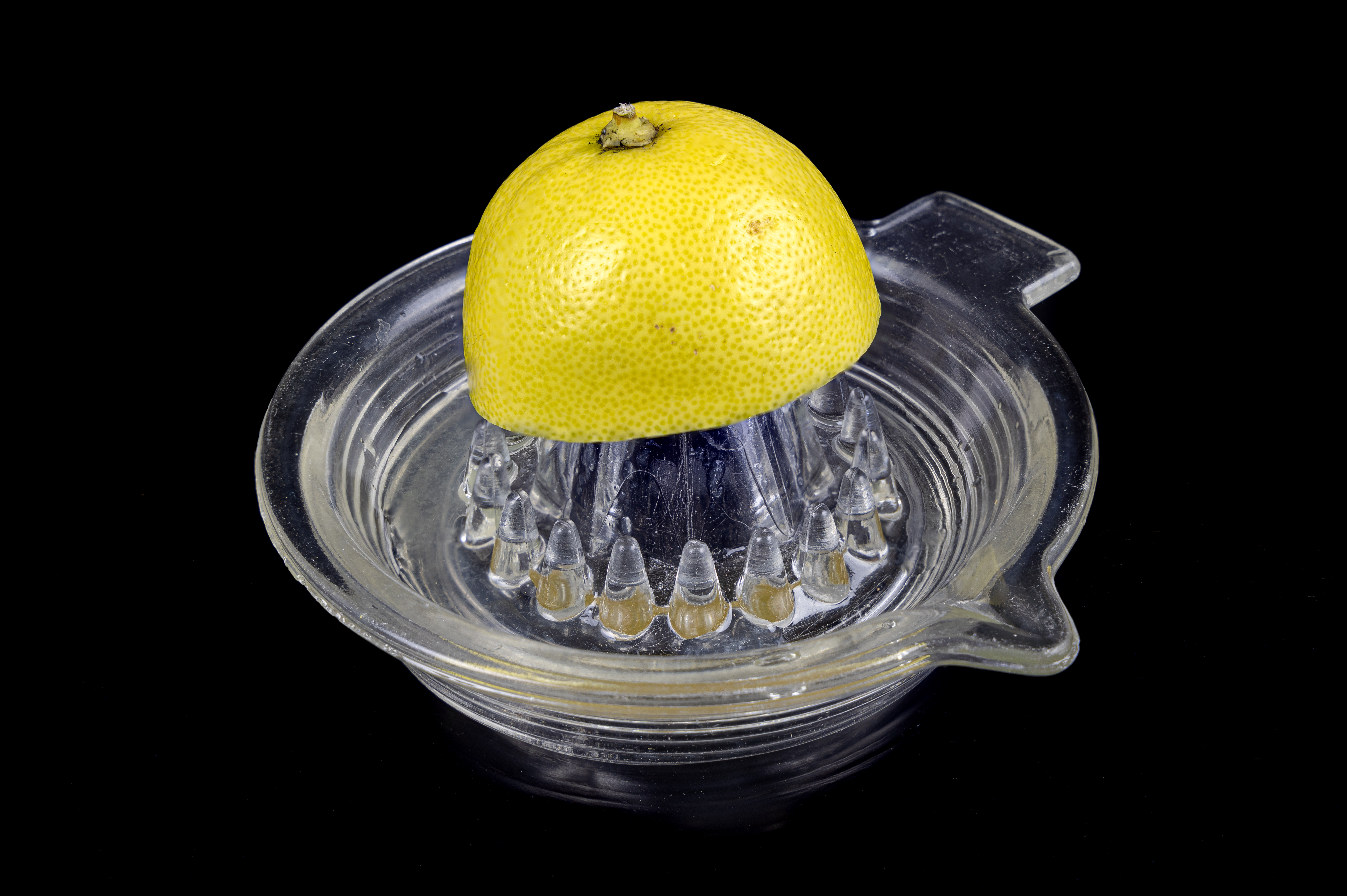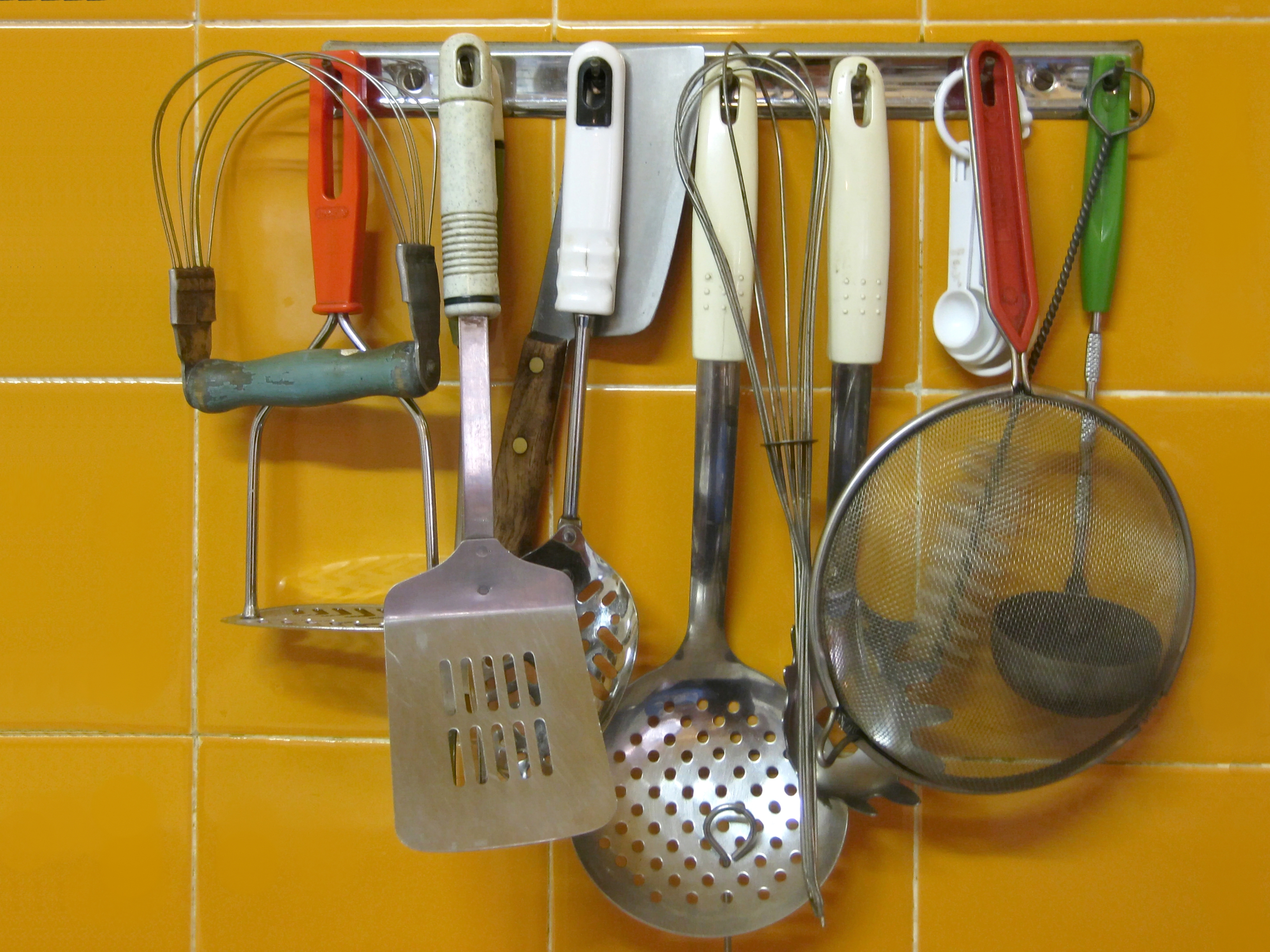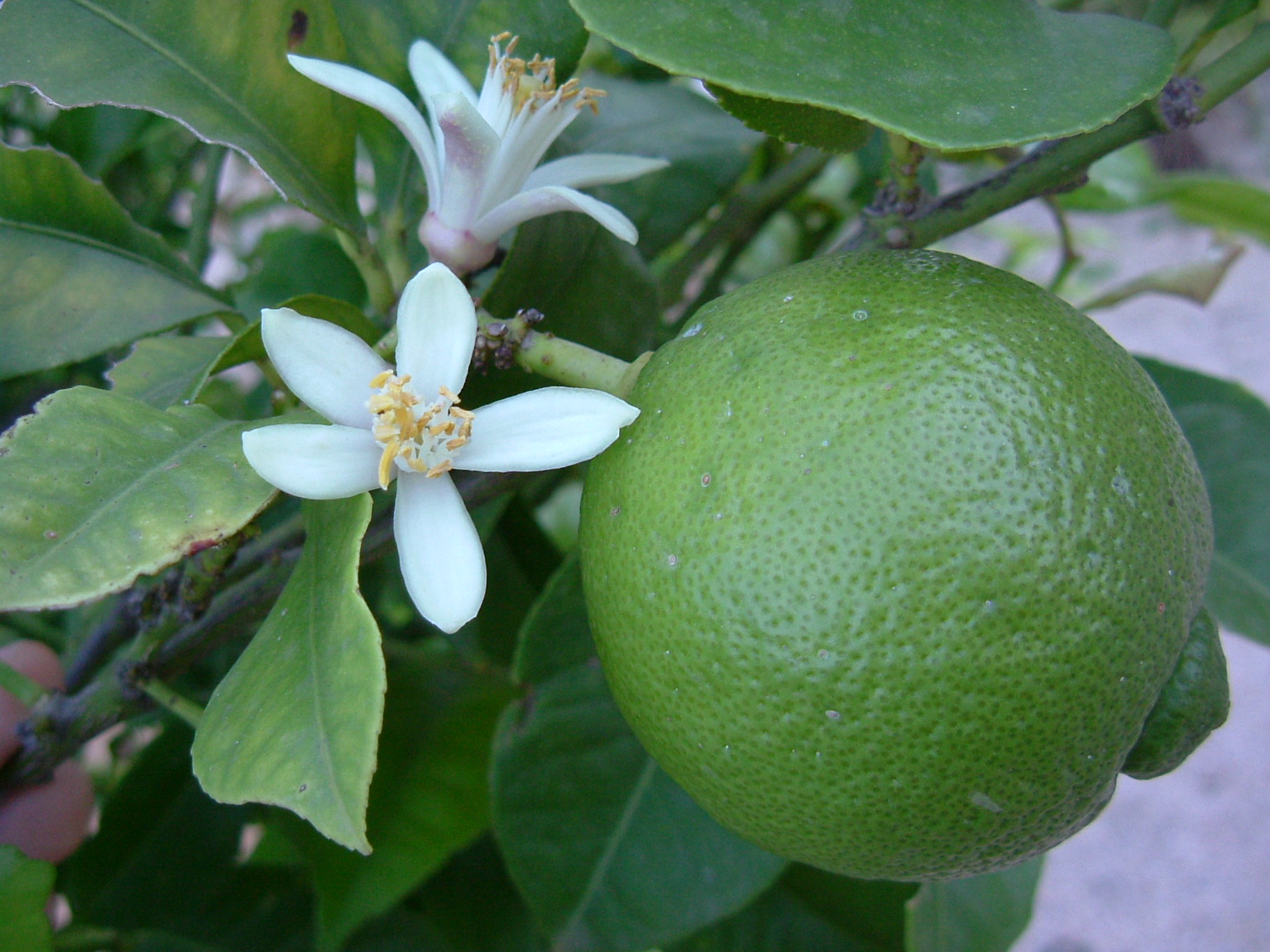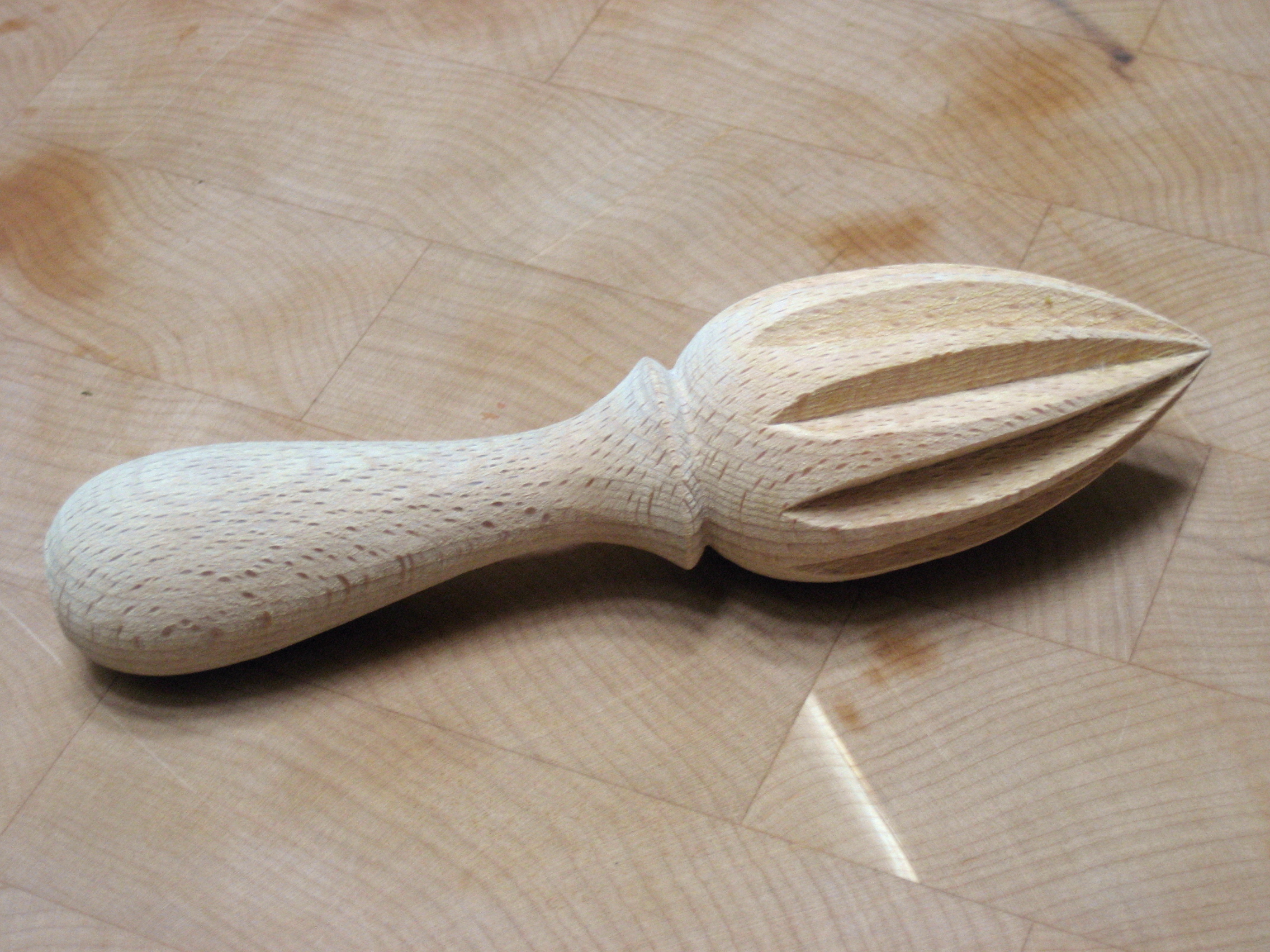|
Citrus Reamer
A citrus reamer, also known as a lemon reamer or simply a reamer, is a small kitchen utensil used to extract the juice from a lemon or other small citrus fruit. The reamer extracts juice using a convexly tapered conical mandrel, with troughs or ridges running the length of the mandrel. The mandrel is mounted either within a dish to catch the juice or on a cylindrical handle. The mandrel is usually made of wood, plastic, or metal. The handheld reamer, which is held in one hand while the lemon or lime is held in the other, is a relatively new adaptation of the traditional glass or plastic citrus reamer (with a juice rim) that was placed on a table and pressed downward. To use the reamer, the user first slices a citrus fruit in half along its equatorial midsection. The mandrel is inserted into the exposed flesh of the fruit and then either the reamer or the fruit is twisted to grind the flesh and extract the juice. This process dislodges the seeds and some amount of pith, so the jui ... [...More Info...] [...Related Items...] OR: [Wikipedia] [Google] [Baidu] |
Metal
A metal (from Greek μέταλλον ''métallon'', "mine, quarry, metal") is a material that, when freshly prepared, polished, or fractured, shows a lustrous appearance, and conducts electricity and heat relatively well. Metals are typically ductile (can be drawn into wires) and malleable (they can be hammered into thin sheets). These properties are the result of the '' metallic bond'' between the atoms or molecules of the metal. A metal may be a chemical element such as iron; an alloy such as stainless steel; or a molecular compound such as polythiazyl, polymeric sulfur nitride. In physics, a metal is generally regarded as any substance capable of conducting electricity at a temperature of absolute zero. Many elements and compounds that are not normally classified as metals become metallic under high pressures. For example, the nonmetal iodine gradually becomes a metal at a pressure of between 40 and 170 thousand times atmospheric pressure. Equally, some materials re ... [...More Info...] [...Related Items...] OR: [Wikipedia] [Google] [Baidu] |
Juicer
A juicer, also known as a juice extractor, is a tool used to extract juice from fruits, herbs, leafy greens and other types of vegetables in a process called juicing. It crushes, grinds, and/or squeezes the juice out of the pulp. Some types of juicers can also function as a food processor. Most of the twin gear and horizontal masticating juicers have attachments for crushing herbs and spices, extruding pasta, noodles or bread sticks, making baby food and nut butter, grinding coffee, making nut milk, etc. Types Reamers Squeezers are used for squeezing juice from citrus such as grapefruits, lemons, limes, and oranges. Juice is extracted by pressing or grinding a halved citrus along a juicer's ridged conical center and discarding the rind. Some reamers are stationary and require a user to press and turn the fruit, while others are electrical, automatically turning the ridged center when fruit is pressed upon. Centrifugal juicers A centrifugal juicer cuts up the fruit or vege ... [...More Info...] [...Related Items...] OR: [Wikipedia] [Google] [Baidu] |
List Of Food Preparation Utensils
A kitchen utensil is a hand-held, typically small tool that is designed for food-related functions. Food preparation utensils are a specific type of kitchen utensil, designed for use in the preparation of food. Some utensils are both food preparation utensils and eating utensils; for instance some implements of cutlery – especially knives – can be used for both food preparation in a kitchen and as eating utensils when dining (though most types of knives used in kitchens are unsuitable for use on the dining table). In the Western world, utensil invention accelerated in the 19th and 20th centuries. It was fuelled in part by the emergence of technologies such as the kitchen stove and refrigerator, but also by a desire to save time in the kitchen, in response to the demands of modern lifestyles. Cornell Un ... [...More Info...] [...Related Items...] OR: [Wikipedia] [Google] [Baidu] |
Lemon Squeezer
A lemon squeezer is a small kitchen utensil designed to extract juice from lemons or other citrus fruit such as oranges, grapefruit, or lime. It is designed to separate and crush the pulp of the fruit in a way that is easy to operate. Lemon squeezers can be made from any solid, acid-resistant material, such as plastic, glass, metal (usually aluminium) or ceramic. History The oldest known lemon squeezers were found in Kütahya, Turkey and date to the first quarter of the 18th century.John Carswell: "The Lemon-Squeezer; an Unique Form of Turkish Pottery" in ''IVème congrès international d’art turc'', pp. 29–45. Éditions de l’Université de Provence, Aix-en-Provence 1971, These ceramic presses are in the traditional style of Turkish pottery of the 18th century and have a superficial resemblance to today's press equipment with cones, though they are designed differently. These examples were individually made, and specially designed for making the then popular citrus ... [...More Info...] [...Related Items...] OR: [Wikipedia] [Google] [Baidu] |
Grapefruit
The grapefruit (''Citrus'' × ''paradisi'') is a subtropical citrus tree known for its relatively large, sour to semi-sweet, somewhat bitter fruit. The interior flesh is segmented and varies in color from pale yellow to dark pink. Grapefruit is a citrus hybrid originating in Barbados. It is an accidental cross between the sweet orange (''C. sinensis'') and the pomelo or shaddock (''C. maxima''), both of which were introduced from Asia in the 17th century. It has also been called the '' forbidden fruit''. In the past it was referred to as the ''pomelo'', but that term is now mostly used as the common name for ''Citrus maxima''. In 2019, world production of grapefruits (combined with pomelos) was 9.3 million tonnes, of which 53% was in China. Other significant producers include Vietnam, United States and Mexico. Description The evergreen grapefruit trees usually grow to around tall, although they may reach . The leaves are long (up to ), thin, glossy, and dark green. They p ... [...More Info...] [...Related Items...] OR: [Wikipedia] [Google] [Baidu] |
Pith
Pith, or medulla, is a tissue in the stems of vascular plants. Pith is composed of soft, spongy parenchyma cells, which in some cases can store starch. In eudicotyledons, pith is located in the center of the stem. In monocotyledons, it extends also into flowering stems and roots. The pith is encircled by a ring of xylem; the xylem, in turn, is encircled by a ring of phloem. While new pith growth is usually white or pale in color, as the tissue ages it commonly darkens to a deeper brown color. In trees pith is generally present in young growth, but in the trunk and older branches the pith often gets replaced – in great part – by xylem. In some plants, the pith in the middle of the stem may dry out and disintegrate, resulting in a hollow stem. A few plants, such as walnuts, have distinctive chambered pith with numerous short cavities (See image at middle right). The cells in the peripheral parts of the pith may, in some plants, develop to be different from cells in the ... [...More Info...] [...Related Items...] OR: [Wikipedia] [Google] [Baidu] |
Seeds
A seed is an Plant embryogenesis, embryonic plant enclosed in a testa (botany), protective outer covering, along with a food reserve. The formation of the seed is a part of the process of reproduction in seed plants, the spermatophytes, including the gymnosperm and angiosperm plants. Seeds are the product of the ripened ovule, after the embryo sac is fertilization, fertilized by Pollen, sperm from pollen, forming a zygote. The embryo within a seed develops from the zygote, and grows within the mother plant to a certain size before growth is halted. The seed coat arises from the Integumentary system, integuments of the ovule. Seeds have been an important development in the reproduction and success of vegetable gymnosperm and angiosperm plants, relative to more primitive plants such as ferns, mosses and marchantiophyta, liverworts, which do not have seeds and use water-dependent means to propagate themselves. Seed plants now dominate biological Ecological niche, niches on land, ... [...More Info...] [...Related Items...] OR: [Wikipedia] [Google] [Baidu] |
Flesh
Flesh is any aggregation of soft tissues of an organism. Various multicellular organisms have soft tissues that may be called "flesh". In mammals, including humans, ''flesh'' encompasses muscles, fats and other loose connective tissues, but sometimes excluding non-muscular organs (liver, lung, spleen, kidney) and typically discarded parts (hard tendon, brain tissue, intestines, etc.). In a culinary context, consumable animal flesh is called meat, while processed visceral tissues are known as offal. In particular animal groups such as vertebrates, molluscs and arthropods, the flesh is distinguished from tougher body structures such as bone, shell and scute, respectively. In plants, the "flesh" is the juicy, edible structures such as the mesocarp of fruits and melons as well as soft tubers, rhizomes and taproots, as opposed to tougher structures like nuts and stems. In fungi, ''flesh'' refers to trama, the soft, inner portion of a mushroom, or fruit body. A more restrictive u ... [...More Info...] [...Related Items...] OR: [Wikipedia] [Google] [Baidu] |
Lime (fruit)
A lime (from French ''lime'', from Arabic ''līma'', from Persian ''līmū'', "lemon") is a citrus fruit, which is typically round, green in color, in diameter, and contains acidic juice vesicles. There are several species of citrus trees whose fruits are called limes, including the Key lime (''Citrus aurantiifolia''), Persian lime, Makrut lime, and desert lime. Limes are a rich source of vitamin C, are sour, and are often used to accent the flavours of foods and beverages. They are grown year-round. Plants with fruit called "limes" have diverse genetic origins; limes do not form a monophyletic group. Plants known as "lime" The difficulty in identifying exactly which species of fruit are called lime in different parts of the English-speaking world (and the same problem applies to synonyms in other European languages) is increased by the botanical complexity of the citrus genus itself, to which the majority of limes belong. Species of this genus hybridise readily, and i ... [...More Info...] [...Related Items...] OR: [Wikipedia] [Google] [Baidu] |
Plastic
Plastics are a wide range of synthetic or semi-synthetic materials that use polymers as a main ingredient. Their plasticity makes it possible for plastics to be moulded, extruded or pressed into solid objects of various shapes. This adaptability, plus a wide range of other properties, such as being lightweight, durable, flexible, and inexpensive to produce, has led to its widespread use. Plastics typically are made through human industrial systems. Most modern plastics are derived from fossil fuel-based chemicals like natural gas or petroleum; however, recent industrial methods use variants made from renewable materials, such as corn or cotton derivatives. 9.2 billion tonnes of plastic are estimated to have been made between 1950 and 2017. More than half this plastic has been produced since 2004. In 2020, 400 million tonnes of plastic were produced. If global trends on plastic demand continue, it is estimated that by 2050 annual global plastic production will reach over 1,1 ... [...More Info...] [...Related Items...] OR: [Wikipedia] [Google] [Baidu] |
Lemon Reamer
A citrus reamer, also known as a lemon reamer or simply a reamer, is a small kitchen utensil used to extract the juice from a lemon or other small citrus fruit. The reamer extracts juice using a convexly tapered conical mandrel, with troughs or ridges running the length of the mandrel. The mandrel is mounted either within a dish to catch the juice or on a cylindrical handle. The mandrel is usually made of wood, plastic, or metal. The handheld reamer, which is held in one hand while the lemon or lime is held in the other, is a relatively new adaptation of the traditional glass or plastic citrus reamer (with a juice rim) that was placed on a table and pressed downward. To use the reamer, the user first slices a citrus fruit in half along its equatorial midsection. The mandrel is inserted into the exposed flesh of the fruit and then either the reamer or the fruit is twisted to grind the flesh and extract the juice. This process dislodges the seeds and some amount of pith, so the jui ... [...More Info...] [...Related Items...] OR: [Wikipedia] [Google] [Baidu] |







